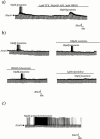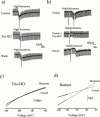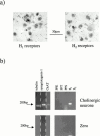Histamine depolarizes cholinergic interneurones in the rat striatum via a H(1)-receptor mediated action
- PMID: 11082121
- PMCID: PMC1572445
- DOI: 10.1038/sj.bjp.0703692
Histamine depolarizes cholinergic interneurones in the rat striatum via a H(1)-receptor mediated action
Abstract
1. Whole-cell patch clamp recordings were made from rat striatal cholinergic interneurones in slices of brain tissue in vitro. Bath application of histamine (EC(50) 6.3 microM) was found to rapidly and reversibly depolarize these neurones through the induction of an inward current at -60 mV. 2. The effects of histamine were mimicked by the H(1) receptor agonist 2-thiazolylethylamine (50 microM) and selectively inhibited by pre-incubation with the H(1) receptor antagonist triprolidine (1 microM). 3. Ion substitution experiments under voltage clamp conditions revealed that the histamine activated current was comprised of two components. One component was sensitive to the concentration of extracellular Na(+), whilst the other component was inhibited by intracellular Cs(+) or extracellular Ba(2+). 4. In situ hybridization experiments revealed that the majority of cholinergic interneurones in the rat striatum express the histamine H(1) receptor but few neurones express H(2) receptors. These findings were confirmed using single cell RT - PCR. 5. It is concluded that histamine depolarizes cholinergic interneurones in the rat striatum via a H(1)-receptor mediated mechanism.
Figures




References
-
- ARRANG J.M., GARBARG M., LANCELOT J.C., LECONTE J.M., POLLARD H., ROBBA M., SCHUNACK W, SCHWARTZ J.C. Highly potent and selective ligands for histamine H3-receptors. Nature. 1987;327:117–123. - PubMed
-
- BELL M.I., RICHARDSON P.J, LEE K. Characterization of the mechanism of action of tachykinins in rat striatal cholinergic interneurons. Neuroscience. 1998;87:649–658. - PubMed
-
- BOUTHENET M.L., RUAT M., SALES N., GARBARG M, SCHWARTZ J.C. A detailed mapping of histamine H1-receptors in guinea-pig central nervous system established by autoradiography with [125I]iodobolypyramine. Neuroscience. 1988;26:553–600. - PubMed
MeSH terms
Substances
LinkOut - more resources
Full Text Sources

